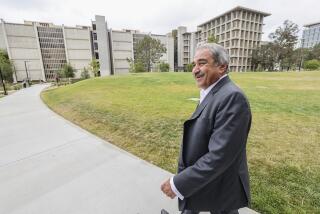Drama of Transplants Relished : Surgeon Heading New UCSD Liver Program Enthusiastic
- Share via
Dr. Oscar Bronsther likes transplanting livers, an often grueling operation averaging 12 hours and involving large amounts of blood, because “it’s exciting, it’s a tremendous rush, it’s saving lives.”
Bronsther, 34, will head the liver transplant program scheduled to begin this spring at UC San Diego Medical Center. He was recruited by UCSD from New York City’s Mt. Sinai Hospital in 1984 with the intent that he would prepare to head such a program.
While Bronsther is aware of the controversy surrounding the 1983-84 program at Sharp Memorial Hospital, he was not in San Diego at the time and hopes to steer clear of any comparisons.
“It would have been better for San Diego if the Sharp program had succeeded, and I’m sorry it did not,” Bronsther said in an interview. “I can’t comment on the specific details of what went on there because I wasn’t here.”
Bronsther is eager, however, to talk about his plans at UCSD. He finds liver transplants unique among surgical procedures.
“Why? Because they are so difficult, even when nothing goes wrong to complicate an operation,” he said. “There are several phases to it, with each phase resembling a complete operation by itself.”
Bronsther said that removing the diseased liver, the first step, is often the most difficult part, requiring three to eight hours alone. At the point where the removal becomes irreversible, doctors must be certain that the donor liver has been properly harvested and preserved, and that it will be suitable for the recipient.
“You have from four to six hours on average to get the donor liver out of the donor’s body and into the recipient,” he said. Often the donor is from another city and tight transportation schedules must be ensured.
“The body does not like not having a liver,” Bronsther said, explaining how three critical connections between the liver and other parts of the body--the heart, intestine and lower body cavity--must be done as quickly as possible once the transplant is in place.
And while the drama is in the operating room, the first six weeks after the surgery are critical in terms of watching for immunological problems, where the recipient’s body attempts to reject the new organ.
Bronsther studied for almost a year at the University of Pittsburgh, where Dr. Thomas Starzl pioneered liver transplants. (Liver transplants are now done at about 20 hospitals nationwide.)
“Less than 2% of the patients at Pittsburgh die from the operation, but 25% to 30% of people die within a year from body rejection, from infection or from transplanted livers that do not function properly,” he said.
The UCSD group of six to nine surgeons is receiving referrals in preparation for its first operation this spring. They are looking for an adult man or woman up to 50 years of age with a failing liver, no significant previous surgery and without other significant medical problems. After any initial problems are worked out, Bronsther hopes that the UCSD program will perform 30 to 50 transplants a year, based on the area’s population.
“We will be operating on people who otherwise have no hope,” he said. “Most of your patients are children or young adults in their 30s, usually women more than men, and people in the prime of life who otherwise might be dead within months or a year or two.
“We’re on the cutting edge of ways to save lives.”






